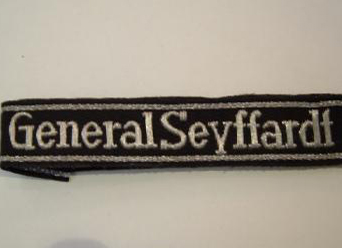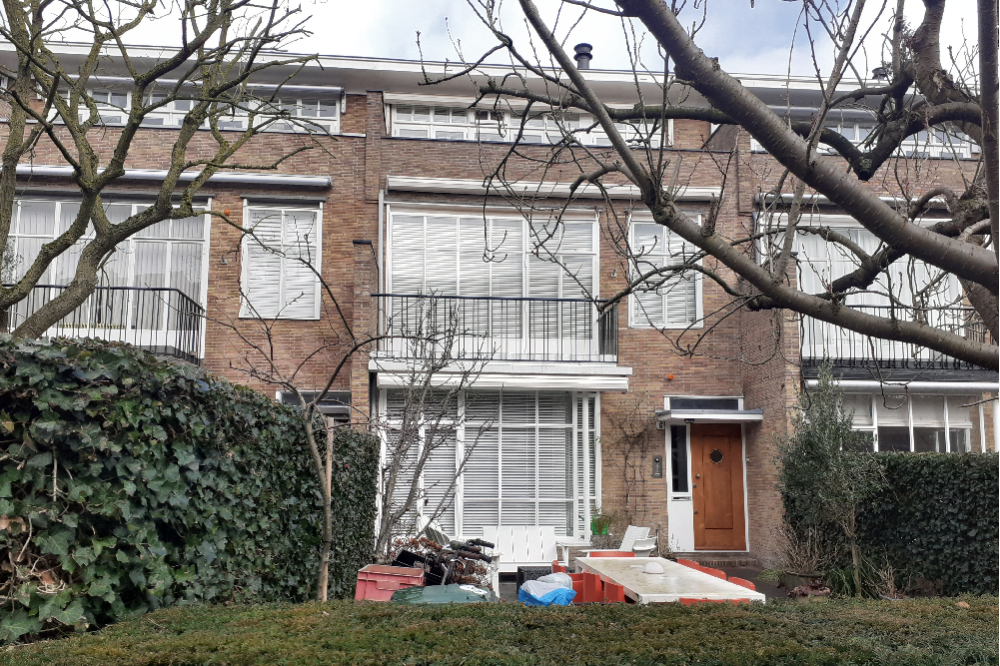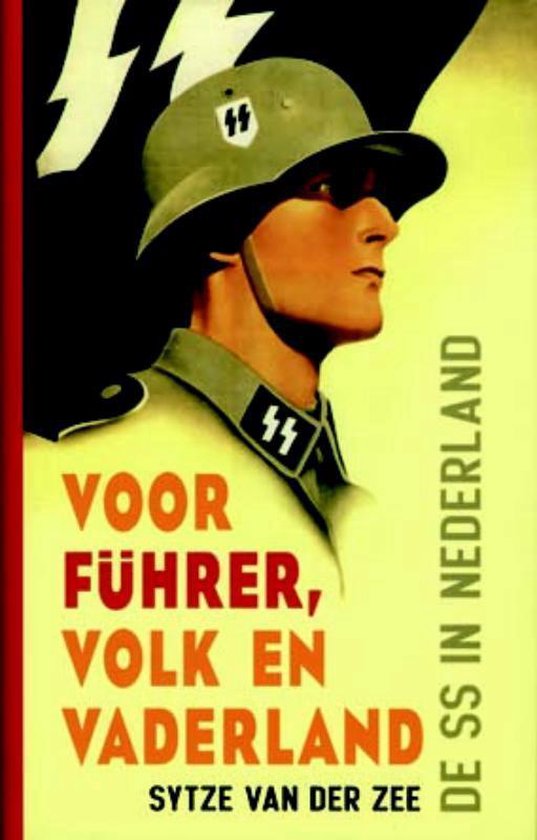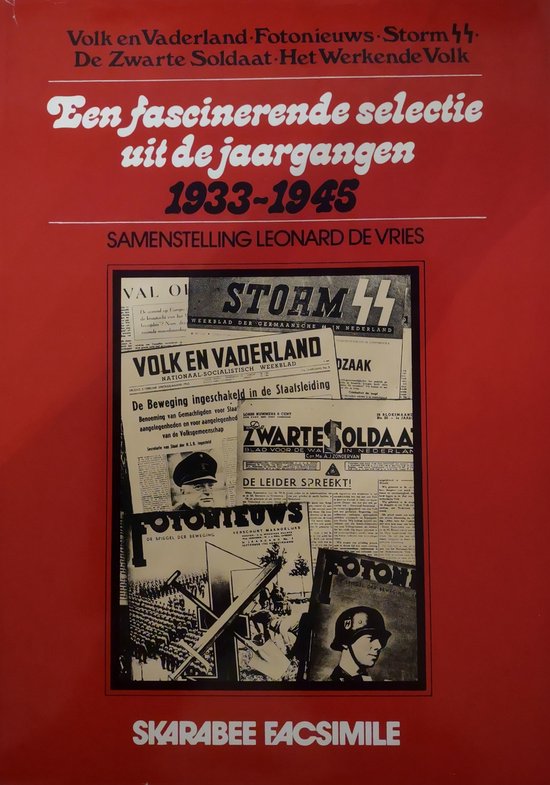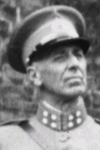Introduction
Hendrik Alexander Seyffardt was born in Breda on the 1st of November, 1872, as son of Louis William Seyffardt August, later Minister of War in the Van Tienhoven Government (1891-1894), and Catharina Louisa de Hollander. August Seyffardt was an officer in the Dutch army and during his ministry he steered a left-liberal course in which he pleaded for general training duty and a citizen army. His ideas were never realized, due to his poor relationship with Queen-Regent Emma.
According to good military tradition, Seyffardt enrolled as a cadet at the Royal Military Academy (KMA) in Breda at the age of fifteen. After his training, he was appointed second lieutenant at the Vestingartillerie (garrison artillery). In 1900, at the age of 28, he subsequently was appointed as a lecturer at the KMA (Royal Military Academy). Next to his teaching, he studied at the Hogere Krijgsschool (higher war college) in Haarlem in order to become qualified for a position within the General Staff. In 1928, as an interim step, he was appointed commander of the first division in the rank of Major General. A year later he was appointed Chief of the General Staff. One year later, in 1930, he was promoted to lieutenant general and in this rank he remained as chief of the General Staff until May 1934. In that month he retired, after a very meritorious career.
After his retirement, his fascist sympathies and his anti-communist ideas in particular became more clear. This became partly evident by his lectures for the highly authoritarian-conservative Verbond voor Nationaal Herstel (Alliance for National Recovery; VNH) led by Van Gybland Oosterhoff and from his articles in "Volk en Vaderland”, the magazine of the National Socialistische Beweging (national socialistic movement; NSB). During his speaking engagements for the VNH he aimed primarily on the pacifist movement (the “broken rifle") and he also pleaded for a stronger army. Furthermore, in 1935, for example, he also fiercely opposed against the then government's decision to join the sanctions against Italy, which had invaded Abyssinia.In 1937, Seyffardt was a member of the NSB for about half a year. Probably he decided to terminate his membership because of the struggles within the movement between Ir. Anton Mussert, "Leider der NSB” and Mr. Meinoud Rost of Tonningen, who preferred a more radical course for the NSB.
It is not clear how Seyffardt experienced the German invasion of the Netherlands. However, shortly after the capitulation he talked about "a changed understanding". Anyway, he was impressed by the German army and the plans of the German occupying forces.
Definitielijst
- capitulation
- Agreement between fighting parties concerning the surrender of a country or an army.
- invasion
- Armed incursion.
- NSB
- National Socialist Movement. Dutch political party sympathising with the Nazis.
- Volk en Vaderland
- People and Fatherland. The daily newspaper of the NSB.
Images
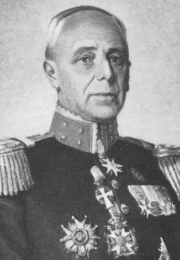 Lieutenant-general Hendrik Seyffardt Source: www.inghist.nl.
Lieutenant-general Hendrik Seyffardt Source: www.inghist.nl.Parents, military career and retirement
Hendrik Alexander Seyffardt was born in Breda on the 1st of November, 1872, as son of Louis William Seyffardt August, later Minister of War in the Van Tienhoven Government (1891-1894), and Catharina Louisa de Hollander. August Seyffardt was an officer in the Dutch army and during his ministry he steered a left-liberal course in which he pleaded for general training duty and a citizen army. His ideas were never realized, due to his poor relationship with Queen-Regent Emma.
According to good military tradition, Seyffardt enrolled as a cadet at the Royal Military Academy (KMA) in Breda at the age of fifteen. After his training, he was appointed second lieutenant at the Vestingartillerie (garrison artillery). In 1900, at the age of 28, he subsequently was appointed as a lecturer at the KMA (Royal Military Academy). Next to his teaching, he studied at the Hogere Krijgsschool (higher war college) in Haarlem in order to become qualified for a position within the General Staff. In 1928, as an interim step, he was appointed commander of the first division in the rank of Major General. A year later he was appointed Chief of the General Staff. One year later, in 1930, he was promoted to lieutenant general and in this rank he remained as chief of the General Staff until May 1934. In that month he retired, after a very meritorious career.
After his retirement, his fascist sympathies and his anti-communist ideas in particular became more clear. This became partly evident by his lectures for the highly authoritarian-conservative Verbond voor Nationaal Herstel (Alliance for National Recovery; VNH) led by Van Gybland Oosterhoff and from his articles in "Volk en Vaderland”, the magazine of the National Socialistische Beweging (national socialistic movement; NSB). During his speaking engagements for the VNH he aimed primarily on the pacifist movement (the “broken rifle") and he also pleaded for a stronger army. Furthermore, in 1935, for example, he also fiercely opposed against the then government's decision to join the sanctions against Italy, which had invaded Abyssinia.In 1937, Seyffardt was a member of the NSB for about half a year. Probably he decided to terminate his membership because of the struggles within the movement between Ir. Anton Mussert, "Leider der NSB” and Mr. Meinoud Rost of Tonningen, who preferred a more radical course for the NSB.
It is not clear how Seyffardt experienced the German invasion of the Netherlands. However, shortly after the capitulation he talked about "a changed understanding". Anyway, he was impressed by the German army and the plans of the German occupying forces.
Definitielijst
- capitulation
- Agreement between fighting parties concerning the surrender of a country or an army.
- invasion
- Armed incursion.
- NSB
- National Socialist Movement. Dutch political party sympathising with the Nazis.
- Volk en Vaderland
- People and Fatherland. The daily newspaper of the NSB.
Establishment of the Volunteer Legion Netherlands
On June 28th, 1941, Arnold Meyer, member of the strongly anti-Semitic and fascist party, called “Nationaal Front”, made a proposal in his “Nederlandsch Dagblad”. He pleaded for a joint establishment of a separate Dutch Legion that would take part in the fight against "the Russian Bolshevism”. Mussert as well as the leaders of the Nederlandse Unie (Dutch Union), Louis Einthoven, Johannes Linthorst Homan and Jan de Quay rejected the proposal. Mussert in particular, because he regarded Meyer as a competitor, but the motive for his rejection was his opinion that such a Legion was unnecessary, since every Dutchman could enlist for the Waffen-SS and the National Socialist Kraftfahrkorps (NSKK, the chauffeurs corps). However, the Germans immediately started to work on this, because for them this would be a new opportunity for a disguised way of recruiting personnel for the Waffen-SS. Late June / early July, Arthur Seyss-Inquart, Reich Commissioner for the Occupied Netherlands, and his collaborators took an interest in the then 69 year old and retired Lieutenant General Hendrik Seyffardt, as commander of the Legion. According to the opinion of Seyss-Inquart, he was both propagandistically as well as practically a good choice: within the armed forces, Seyffardt was known as a highly skilled soldier and was strong nationalistically oriented. Not unimportant was also the fact that the general at that time, was not a member of a collaborating party. The new formation had to have the appearance of being essentially a-political.
On July 1st, 1941, the German authorities had approached Seyffardt by the Dutch police inspector, the reserve first lieutenant of artillery A.R.Kleijn. Two days later, the founder of the Cultuurkring (Cultural Circle) and co-founder of the Nederlandsche Duitsche Kultuurgemeenschap, Prof. G.A. Snijder, did the same. On July 5th, 1941, Hitler officially approved the establishment of a volunteer group and on July 8th, Seyffardt agreed with Seyss-Inquart, Hanns Albin Rauter, the Höhere SS- und Polizeiführer and General Commissioner for safety in the Netherlands, and Generalkommissar Fritz Schmidt, that he officially would be appointed as commander of the Legion. However it should then already have been clear to him, that he would not get any military power. The former chief of staff would only be in charge of the regional headquarters of the Vrijwilligers Legioen Nederland, as the formation was named, and as such responsible for enlisting recruits and for the Fürsorge (social assistance) to the Legion soldiers and their families. SS-Standartenführer (Colonel) Otto Reich was appointed military commander, an appointment which, later on, proved to be an unfortunate choice. A.R. Kleijn was appointed chief of staff of Seyffardt.
From the moment these roles were defined, Seyffardt was pushed forward as commander by the Germans. For Mussert, the appointment of Seyffardt was, after his retirement from the NSB, a reason to look at the Legion with even more suspicion. According to the words of Seyffardt himself, a deep gorge emerged between the NSB and the Legion. Despite this, he did everything to give the Legion at least a semblance of a Dutch formation. Something he himself believed in, since the Germans promised Seyffardt that the Legion would be a pure Dutch affair. Meanwhile, in a memorandum to Seyss-Inquart, Meyer had stipulated that the Legion would be led by Dutch officers and NCO’s, that Dutch uniforms would be worn and the Legion was going to operate under the Dutch flag. What he and the other Dutch involved did not know, was that all volunteer units from Germanic countries would come under the Waffen-SS, as stated by Seyffardt at the official announcement of the establishment of the Legion, on June 10th through pamphlets and on June 11th through the unified press: "I considered it my duty to initiate the establishment of a Dutch volunteer corps, that together with the already fighting forces of all European minded nations, comes to the rescue of the German army and the Dutch, who already are in their ranks, and to lighten their task. I consider this not only as a duty, but as a privilege that we can fight for our European freedom and the preservation of our culture, in order to prevent accepting them as a charity from other hands".
Recruitment agencies were opened in eight major cities. At that time, Mussert was still skeptical and ordered all NSB members who wanted to volunteer, to enlist only at the headquarters of the NSB in Utrecht. He had, by now, realized that further resistance was useless, and therefore tried to get even more grip on the Legion. However, he sticked to his reserves towards Seyffardt. In the first months after its establishment, about 1,300 volunteers enlisted for the Legion. Amongst them were about thirty officers from the former Dutch army. This was the first disappointment for the newly appointed Seyffardt. He clearly had hoped for and counted on more applications, especially from the Dutch army. Apart from that, the establishment of the Legion was accelerated: on July 26th, 1941, the first contingent of volunteers, some 650 men, already departed and on August 7th, the second contingent. The 800 men of the Weer Afdeeling (WA), as promised by Mussert, were not included.
Definitielijst
- NSB
- National Socialist Movement. Dutch political party sympathising with the Nazis.
- resistance
- Resistance against the enemy. Often also with armed resources.
- WA
- Abbreviation of defence department, assault groups of the NSB
- Waffen-SS
- Name of Military section of the SS.
Increasingly into the background
It became more and more clear to the Dutch, who were involved in the Legion, that previous promises from Seyss-Inquart, regarding the independence of the Dutch Legion, would not be fulfilled. Thus the call of Arnold Meyer to prohibit a purely Dutch Legion was smothered by his party, the National Front. Meanwhile, the Waffen-SS, in the person of SS-Hauptsturmführer Karl Leib, head of the SS Ergänzungsstelle Nordwest in The Hague, got more and more grip on the Legion. Seyffardt protested, but nevertheless he remained committed to the Legion. However without much result, because the large influx of volunteers and former officers of the Dutch army, expected by the Germans, stopped out during the first month.
At the start of their training in East Prussia, the volunteers discovered that they, like the Danes and Norwegians, would perform their service in the uniform of the Waffen-SS. Only the symbol of the NSB, the Wolf Angel, the “orange-banje bleu” shield on the sleeve and the song that was specially composed for the Legion, were Dutch:
“Dietschers en Duitschers in den marsch vooraan In Groot-Germaansche vrijheidsstrijd Wij stormen voort - Wij breken baan Ons lied klinkt dapper wijd en zijd Pantsers stooten door - Stuka’s vallen aan Dietschers en Duitschers in den marsch vooraan”.
A total of 265 men who had enlisted, returned home earlier than expected due to various reasons. There were problems between the German principals and the Dutch recruits, who were regarded as inferior by their drill instructors. Moreover, SS-Standartenführer Otto Reich appeared to have a strong rejection of the Dutch. It also appeared that many recruits were taken to Debica, Poland, under false pretences and some refused to take the oath to Adolf Hitler. Furthermore, Reich let tempers run high when he offered the Legion soldiers three choices in response to a conflict between Reich and Himmler: stay and pass into the Waffen-SS, enter into the service of a fictional WA regiment or go home. Because of this incident, the deputy leader of the NSB, Cornelis van Geelkerken, paid a visit to the Legion and managed to calm things down.
In spite of this all, Mussert still considered the Legion as a future Dutch army wherefore the leaders would be trained at the Eastern front. Therefore he called on his supporters to enlist. This way, they were to constitute about 30% of the total Legion. This way Mussert tried to strengthen the grip of the NSB, but it was the Waffen-SS who already called the shots. For Seyffardt this meant that he, as the official commander, was pushed ever further into the background and lost more and more influence. His renewed, secret membership of the NSB, "sympathizer No. 1”, and his “favoured membership” of the Dutch SS were probably an attempt to reverse that tide. It did not help and he had to settle for a ceremonial position. Taking parades of departing volunteers was to become his main task. It was a big disappointment for Seyffardt when he was not given the opportunity to visit the Legionaries on the Eastern front.
In March 1942, he even submitted his resignation as commander of the Legion with Hanns Rauter and Arthur Seys-Inquart. Apparently they knew to convince him stay, because a few days later, he announced that he still remained in office. Early February 1943, Seyffardt still was appointed "gemachtigde van de Leider voor aangelegenheden betreffende het Legioen” (deputy of the Leader for matters relating to the Legion) by Mussert, who had abandoned his objections, because of Seyffardt's membership of the NSB and his own, changed, understanding. Seyffardt also held a speech on this occasion and was quoted in “ Volk en Vaderland”:
"If the Dutch people want to claim the commitment of legal equality by the Führer, it must do something. And therefore the well-intentioned men have to fight along with Germany and its allies".
Definitielijst
- Führer
- German word for leader. During his reign of power Adolf Hitler was Führer of Nazi Germany.
- NSB
- National Socialist Movement. Dutch political party sympathising with the Nazis.
- regiment
- Part of a division. A division divided into a number of regiments. In the army traditionally the name of the major organised unit of one type of weapon.
- Volk en Vaderland
- People and Fatherland. The daily newspaper of the NSB.
- WA
- Abbreviation of defence department, assault groups of the NSB
- Waffen-SS
- Name of Military section of the SS.
Prelude to the liquidation
On December 13th, 1942, Mussert was officially appointed "Leader of the Dutch People“ by the German occupying forces. With direct permission from Hitler, he was allowed to establish a “Secretarie van Staat der Nationaal-Socialistische Beweging der Nederlanden” (secretary of State of the National Socialist Movement of the Netherlands). This institute would consist of several “deputies”; each with their own portfolio. From February 1st, 1943, they would advise Seyss-Inquart on their specifically assigned department. In this way Rost van Tonningen functioned as advisor for the following areas: Finance, Banking, Special Economic Affairs and the East company. Prof. Mr. Dr. Robert van Genechten got the appointment for the following areas: Education, Arts and Sciences. Cornelis van Geelkerken took place as a consultant in the field of Internal Affairs and National Security. And Seyffardt was appointed “Deputy for special services” regarding the Dutch Legion. His role as "Deputy" was announced on Thursday, February 4th, through the press.
The communist resistance group CS-6, under the leadership of Dr. Gerrit Kastein, thought that this series of events would lead to a national-socialist government, led by Mussert. CS-6 feared that Mussert, as soon as the government was installed, would introduce the general conscription and would call up Dutchmen for the Eastern front. According to CS-6, Lieutenant General Seyffardt was the first person, eligible for an attack, after the heavily secured Mussert. He was the symbol for the military collaboration and CS-6 saw in him the future Secretary of War. Seyffardt would carry out Mussert’s policy regarding the deployment of Dutch troops on the Eastern front. This made him a threat, according to CS-6.
The reality was quite different. The German occupying forces looked upon the NSB primarily as a reservoir for administrative, military and para military forces. Also, the Movement was an useful medium to reach the Dutch people. The NSB was indeed still the largest national socialist organization in the Netherlands, especially after the dissolution of other fascist and national socialist parties. However, the Germans, had no intention at all to appoint Mussert head of government. Because of these reasons and others, they wanted to engage Mussert’s loyalty and gave him and his supporters the impression to be taken serious. Moreover, a few months earlier, Seyss-Inquart had stated to Mussert that he had no intention to introduce a general conscription in the Netherlands.
Definitielijst
- collaboration
- Cooperation of the people with the occupying forces, more generally spoken the term for individuals who cooperate with the occupying force is collaborator.
- NSB
- National Socialist Movement. Dutch political party sympathising with the Nazis.
- resistance
- Resistance against the enemy. Often also with armed resources.
Liquidation
In the early morning of February 5th, 1943, the attack was carried out by Kastein and a CS-6 member, the student Jan Verleun. Verleun fired the two fatal shots at Seyffardt, in the doorway of Seyffardts’ house in Scheveningen. On February 12th, the following was published in "Volk en Vaderland”:
"In the evening of the 4th (actually early in the morning of the 5th) February, suddenly two individuals in the darkness, were in front of him and asked if he was General Seyffardt. There was no hesitation. The answer loud and clear: "Yes, I'm General Seyffardt “. Two shots and he collapsed, seriously injured. With exertion of his utmost powers he managed to communicate his injuries by telephone. One of his last wishes was not to shoot hostages for his sake. He has had the great privilege to fall as a soldier at an age when others die in their beds. This fills us with emotions and tempers our grief."
The next day, February 6th, Seyffardt died of his injuries in the hospital. A few days after his death, a farewell meeting with great military honours was organized for him in The Hague. Subsequently, a ceremony was held at which only his family and a few friends were present before he was cremated.
Definitielijst
- Volk en Vaderland
- People and Fatherland. The daily newspaper of the NSB.
Images
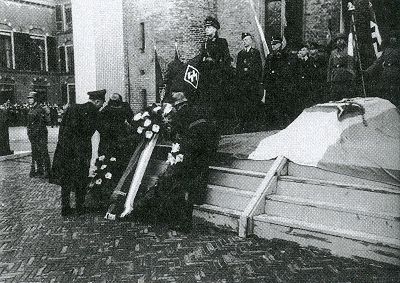 The funeral of Seyffardt. Mussert is laying a wreath at the Binnenhof , The Hague Source: www.dbnl.org).
The funeral of Seyffardt. Mussert is laying a wreath at the Binnenhof , The Hague Source: www.dbnl.org).Consequences
Reichsführer-SS Heinrich Himmler ordered to shoot fifty "Orange" hostages after Hanns Rauter had informed him, by telephone, about Seyffardt’s death. This in spite of Seyffardt’s last wish not to take reprisals. The German occupier decided not to carry out Himmler's order. This decision was taken because they did not want the unrest among the Dutch population to increase even more. However, raids were held at various colleges and universities in Amsterdam, Delft and Wageningen. In fact, Seyffardt had been able to state that he firmly believed that the attack had been the work of students. About 600 students were arrested and transferred to camp Vught. Around 150 were deported to Germany, later on. Another consequence of the fact that especially students were considered as the perpetrators of the attacks, was that the students had to sign a “declaration of loyalty of the students” in order to study.
On February 7th, new victims were made by CS-6. “Gemachtigde voor de Volksvoorlichting” (Attorney for the national relations) Mr. H. Reydon and his wife. His wife died on the spot, Reydon himself still died six months later of his injuries, on August 24th. Henk Feldmeijer, leader of the Dutch (later on, the Germanic) SS, was out on revenge, because the resistance continued to carry out attacks on prominent NSB, collaborators and police officers. Together with Rauter, he worked out Aktion Silbertanne, also known as the “Silbertanne murders” in which Sondercommando Feldmeijer, mainly consisting of Dutch Eastern front Veterans, supported by the Sicherheitsdienst (SD) carried out liquidations of Dutch people, in retaliation for the attacks on collaborators. For every murdered Dutch national socialist or German, three Dutch, preferably intellectuals and opponents of the Nazi regime, would be shot. Silbertanne Aktion started in September 1943 and would be continued in two phases, until September 1944, killing at least 55 Dutch.
The series of attacks did not end up well for CS-6. Prior to the attack at Reydon took place, the SD already was aware of the plans of CS-6. In fact, Kastein was betrayed by a “Vertrouwensman” (agent) of the SD, Anton van der Waals. Van der Waals lent a gun to Kastein, who used it for the attack at Reydon. This was because Verleun had taken away the gun, which he used for the attack at Seyffardt, and was in hiding since then. The SD was willing to let go of Kastein in order to get to know more about the plans of CS-6 through V-man Van der Waals. However, without the knowledge of the SD, the Security Police (Sipo) arrested Kastein on February 19th. To prevent himself of betraying his resistance group, Kastein committed suicide at the Binnenhof in The Hague by jumping out of the window of the second floor, in front of the eyes of the Sipo officers. The Germans already had a large part of the resistance group on the grain and by arresting Kastein, the majority of the group would be rolled up. With the remaining group members, Verleun increased the number of attacks, but was eventually betrayed and arrested on January 7th, 1944 and subsequently shot at the Waalsdorpervlakte.
Definitielijst
- Nazi
- Abbreviation of a national socialist.
- NSB
- National Socialist Movement. Dutch political party sympathising with the Nazis.
- resistance
- Resistance against the enemy. Often also with armed resources.
- Sicherheitsdienst (SD)
- The national socialistic intelligence and counterespionage service of the SS.
- Sipo
- ”Sicherheitspolizei”. Combination (since 1936) of the Gestapo and criminal police.
Epilogue
The attack on Seyffardt resulted in a change of attitude of the resistance regarding liquidations. Before February 5th, 1943, liquidations served as protection against danger netting collaborators, but the liquidation of Seyffardt was the first in the series of attacks as a sort of public execution. For the German occupying forces and those who collaborated with the occupier, these attacks were the starting signal of a change to harsh retaliation. The sad thing is that the retaliations to a large extent, were carried out by collaborating Dutchmen.
In December 1943, after the Legion was removed from the front near Leningrad, the Legion was transformed into a brigade: the 4. SS-Freiwilligen-Brigade “Nederland”. This after Mussert rejected an earlier plan to unite a division of the Dutch, Norwegian and Danish Legions. One of the two new SS-Panzer-Grenadier Regimenter, number 48, was at that time named after Seyffardt: "General Seyffardt” (Niederländisches Nr. 1). When in December 1944, the Brigade got the status of division (given in the name; not in numbers), the regiment was named “48. SSFreiwilligen-Panzergrenadier-Regiment General Seyffardt”. In April 1945 the regiment was separated from the other regiment in “Nederland”, 49. SS-Freiwilligen-Panzergrenadier-Regiment de Ruyter. “De Ruyter” stayed at the front near the Oder and finally surrendered to the Americans in Parchim on May 3rd, 1945. On the contrary, “General Seyffardt“ was split and partially perished with Kampfgruppe Viewegeren at Hammerstein. The survivors ended up in Russian captivity. Here they were relatively well treated, apart from a few summary executions, and they could therefore return to the Netherlands. The part of "General Seyffardt” that had ended up at Korps Gruppe Tettau was more lucky and could surrender to the Western Allies.
Definitielijst
- brigade
- Consisted mostly of two or more regiments. Could operate independently or as part of a division. Sometimes they were part of a corps instead of a division. In theory a brigade consisted of 5,000 to 7,000 men.
- Kampfgruppe
- Temporary military formation in the German army, composed of various units such as armoured division, infantry, artillery, anti-tank units and sometimes engineers, with a special assignment on the battlefield. These Kampfgruppen were usually named after the commander.
- regiment
- Part of a division. A division divided into a number of regiments. In the army traditionally the name of the major organised unit of one type of weapon.
- resistance
- Resistance against the enemy. Often also with armed resources.
Images
Information
- Translated by:
- Chrit Houben
- Published on:
- 19-01-2025
- Feedback?
- Send it!
Related sights
Related books
Sources
- JONG, L. DE, Het Koninkrijk der Nederlanden in de Tweede Wereldoorlog, Staatsuitgeverij, Den Haag, 1972.
- PIERIK, P., Van Leningrad tot Berlijn, Aspekt, Soesterberg, 2006.
- VRIES, L. DE (RED.), Volk en Vaderland - Fotonieuws - Storm SS - De Zwarte Soldaat - Het Werkende Volk, Skarabee, Laren, 1973.
- ZEE, S. VAN DER, Voor Führer, volk en vaderland, Just Publishers, Hilversum, Nederland, 2008.
